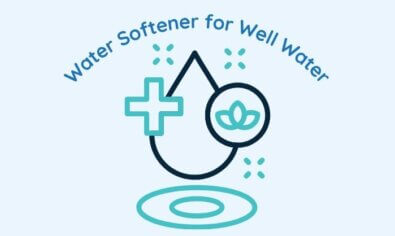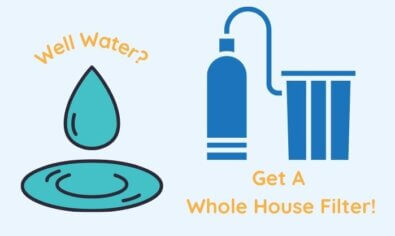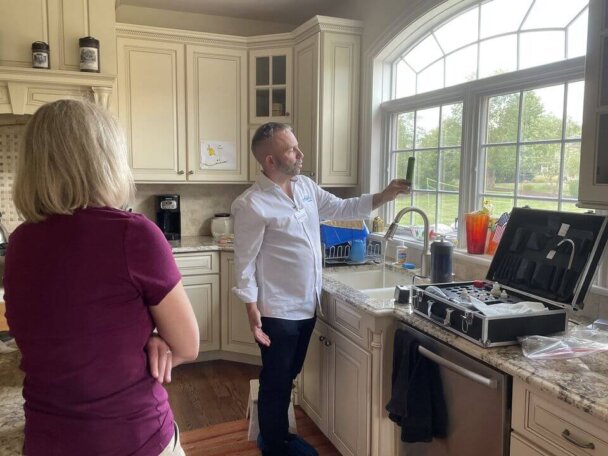Where Does My Tap Water Come From?
Ever wonder about the hidden journey your tap water takes before it reaches your glass?
- Uncover the source: Trace the origins of your tap water, from sprawling lakes to hidden underground aquifers.
- Safety secrets revealed: Demystify the treatment process and learn whether your water is truly safe to drink.
- Local water watch: Discover the unique water challenges in the Chicagoland and West Palm Beach communities and how they could impact your family’s wellbeing.
- Explore your treatment options: Find the perfect water filtration solution for your home, from simple filters to whole-house systems.
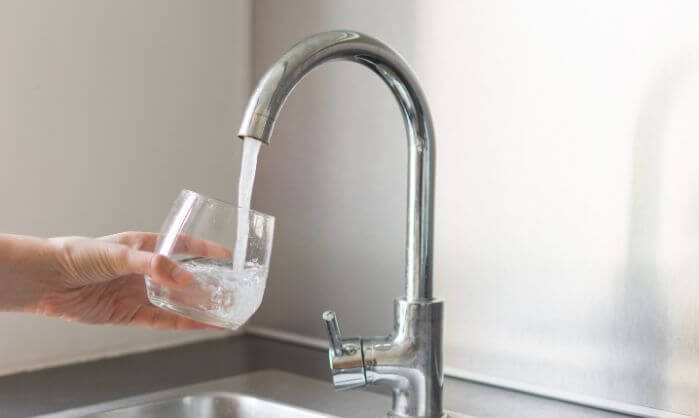
- Uncover the source: Trace the origins of your tap water, from sprawling lakes to hidden underground aquifers.
- Safety secrets revealed: Demystify the treatment process and learn whether your water is truly safe to drink.
- Local water watch: Discover the unique water challenges in the Chicagoland and West Palm Beach communities and how they could impact your family’s wellbeing.
- Explore your treatment options: Find the perfect water filtration solution for your home, from simple filters to whole-house systems.
The water flowing from your faucet has a fascinating story to tell, one that begins far beyond your home’s plumbing. Let’s dive into the world of tap water, exploring its sources, treatment processes, and the measures in place to ensure its safety.
The Water Cycle: Nature’s Purification System
At the heart of our freshwater supply is the water cycle, sometimes referred to as the hydrologic cycle, a natural process that has been occurring for billions of years. This cycle is essentially Earth’s own distillation system, constantly purifying and redistributing water across the planet for drinking, bathing, cooking, sanitation, and much more.
How the Water Cycle Works
While there are many complex (and not completely understood) influences on the movement of water through Earth’s ecosystem, here are the 4 main elements of our water cycle:
- Evaporation: The sun heats water in oceans, lakes, ponds, and rivers, turning it into vapor.
- Condensation: As water vapor rises, it cools and forms clouds.
- Precipitation: Water falls back to Earth as rain or snow.
- Collection: Rainwater and snowmelt collect in bodies of water or seep into the ground.
This cycle is crucial for replenishing our freshwater sources, including Lake Michigan in Illinois, the Grassy Waters Preserve in West Palm Beach, and the myriad other reservoirs, rivers, and aquifers that supply our tap water across the US. Understanding this process helps us appreciate the delicate balance of our water resources and the importance of conservation.
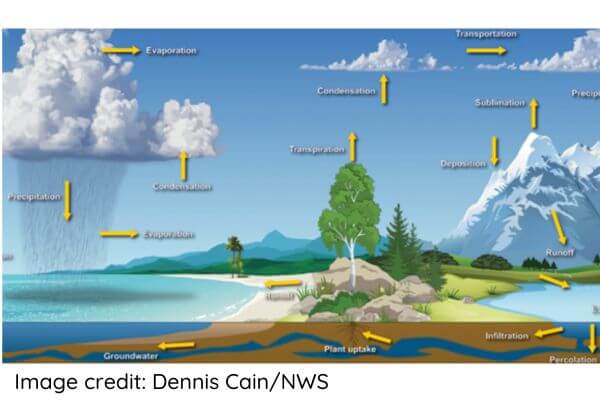
From Source to Tap or Well: The Urban Water Journey
In this country’s population centers, the production of consumable tap water involves several steps, forming what is called the urban water cycle. This process ensures that water is collected, treated, and distributed safely to millions of homes and businesses.
- Your Water Sources
Most tap water in the United States comes from surface water (reservoirs, lakes, and rivers) or from underground aquifers accessed through drilling a well. The source of your water depends on your location and local geography.
For example, cities near large lakes or rivers often rely on surface water, while areas like parts of southeast Florida and northern Illinois with abundant groundwater may depend more on well systems.
- Collection and Treatment
Once collected, tap water undergoes a rigorous treatment process. Public water utilities remove harmful germs and chemicals to make tap water safe for consumption. The treatment typically involves:
- Coagulation and flocculation: Chemical coagulants such as aluminum sulphate, ferric sulphate, and ferric chloride are added to the water to make dirt and other particles stick together.
- Sedimentation: The larger particles settle to the bottom of water tanks.
- Filtration: The water passes through various filters to remove smaller particles
- Disinfection: Usually done with chlorine, this step kills any remaining harmful bacteria and viruses.
Additional treatments may be applied depending on the source water quality and local regulations. For instance, many municipalities add fluoride to promote dental health and hygiene.
- Distribution
After treatment, water is distributed through a network of pipes to homes and businesses. This complex system of underground pipes, pumps, valves, and holding tanks ensures that clean water reaches every tap in the service area.
Water towers often play a crucial role in this stage, using gravity to maintain consistent water pressure throughout the system.
- Storage and Use
Finally, the water reaches your home, ready for use. It’s important to note that the quality of your tap water can be influenced by your home’s plumbing system, especially in older homes with lead pipes or copper pipes with lead solder.
Tap Water Safety: What You Need to Know
In the United States, tap water safety is regulated by the Environmental Protection Agency (EPA). The EPA sets standards for over 90 potential contaminants, including microorganisms, chemicals, and harmful minerals. These standards, known as the National Primary Drinking Water Regulations, are legally enforceable and designed to protect public health.
Illinois Water Utilities have been reporting some gross contaminants!
Check out the concerning contamination that has been reported by public water utilities in Illinois!

Well water is considered generally safe as it’s naturally filtered through layers of soil and rock to reach the aquifer. However, it’s crucial to test your well water regularly to protect your loved ones against potential contamination by:
- Microorganisms: Bacteria, viruses, and parasites can cause immediate negative health effects, particularly in vulnerable residents like children or the elderly.
- Inorganic contaminants: Lead and copper, often from outdated pumping systems, can leach into water and pose serious health risks.
- Industrial chemicals: Pesticides, industrial byproducts, and other synthetic chemicals can contaminate underground water sources.
- Radionuclides: Naturally occurring radioactive materials such as uranium, radium, and radon can be present in some groundwater sources.
Public water systems are required to test their water regularly and provide annual reports to consumers. These Consumer Confidence Reports detail the water’s source, detected contaminants, and compliance with EPA standards. Consumers can request these reports from their local water utility to stay informed about their water quality.
Common Water Issues in Barrington and Northern Illinois
In the Barrington and Chicagoland areas, our water sources vary:
- Lake Michigan: Many municipalities, including Chicago, source their water directly from this Great Lake. This vast freshwater resource provides high-quality water, but it’s not without challenges — the lake faces threats from pollution, invasive species, and climate change.
- Municipal wells: Some suburbs rely on deep aquifer wells. These wells tap into underground water sources that can be hundreds of feet deep. But according to a report by the Chicago Tribune, nearly a million Illinoisans get their drinking water from municipal wells contaminated with toxic forever chemicals at levels exceeding state health guidelines.
- Private wells: In more rural areas, private wells are common. These wells draw from shallower aquifers and require regular maintenance and testing by homeowners.
Each source presents unique challenges. Lake Michigan water, while generally of high quality, contains trace pharmaceuticals and microplastics. Well water in northern Illinois often contains high levels of naturally occurring iron and manganese, which can cause staining and unpleasant tastes.
What You’re Drinking in West Palm Beach and Southeast Florida
In our Southeast Florida service area, including West Palm Beach, water sources include:
- Surface water: From Lake Okeechobee and local canals. These sources are vulnerable to agricultural runoffs and algal blooms, particularly during rainy seasons.
- Biscayne aquifer: A shallow groundwater source that provides water to millions in West Palm Beach and other south Florida communities. Its proximity to the surface makes it vulnerable to contamination from human activities.
- Floridan aquifer: A deeper, more mineralized source. While less vulnerable to surface contamination, it often requires more extensive treatment due to its high mineral content.
Florida’s water faces unique challenges due to its geography. In coastal areas, saltwater intrusion is an increasing concern due to rising sea levels and over-pumping of freshwater aquifers. Since 1950, Florida has experienced 8 inches of sea level rise.
Protect Your Family with Water Testing and Filtration
While municipal water is treated to meet safety standards, many homeowners, especially those with private wells, choose to further purify their water for taste, odor, or additional safety.
Common treatment methods include:
- Reverse osmosis: These systems can remove a wide range of contaminants, including dissolved solids, heavy metals, and some organic compounds. They produce very pure water but can be somewhat costly and waste some water in the process.
- Water softeners: These systems reduce hardness caused by calcium, magnesium, and other minerals. They can extend the life of appliances and improve soap lathering but don’t remove certain other types of contaminants.
- Whole house filtration systems: These systems treat all the water entering your home. They can be customized to address specific water quality issues and provide comprehensive protection.
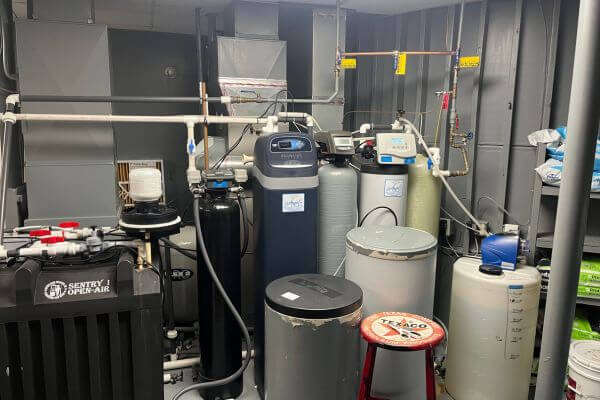
When to Test Your Water
Consider testing your water:
- Annually for insidious new contaminants
- If you notice changes in taste, odor, or appearance
- After nearby construction or land disturbances
- If family members experience recurring gastrointestinal illnesses
- When a baby joins the household
Comprehensive EPA-certified water testing services performed by licensed plumbers can provide an in-depth analysis and data-driven actionable steps. This information is invaluable in determining if you need additional water treatment and what type would be most effective.
Get Started Today
Understanding where your tap or well water comes from and how it’s treated is the first step in ensuring your household’s continued health and safety. Whether you rely on municipal water or a private well, staying informed about your water quality is essential.
Remember, water is a precious resource. By understanding its journey and taking steps to protect and conserve it, we can ensure safe, clean water for generations to come.
If you’re concerned about your water quality or interested in home water treatment options, call or click today to schedule a visit from our licensed plumbing experts. It’s the best way to determine your specific water needs and ensure your family is drinking the safest, cleanest water possible!
Interested in a Water Softener System for Your Home?
You don’t have to live with a dry, itchy scalp and brittle hair anymore! It would be our pleasure to help you find the right water softener to make your showers enjoyable again.
Please give us a call at (847) 382-7800 or visit our water softener page to learn more.

